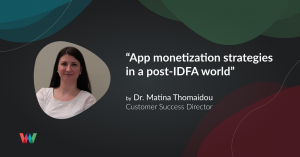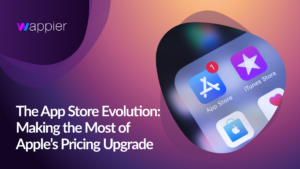You can often find me at mobile gaming conferences, and I would have been in Barcelona for Gamesforum. Then came Covid-19, and with it all events came to a grinding halt. In response to the global shelter-in-place measures, Gamesforum launched Gamesforum Online, where I recently moderated a virtual panel on monetization trends. I was joined by three F2P monetization experts: Vladimir Funtikov, co-founder and CEO of Creative Mobile; Patrick McGrath, Product Lead of June’s Journey at Wooga; and Simo Piispanen, Product Owner of Hotel Hideaway at Sulake. In our panel, we talked through the process of developing a top game, examined F2P trends, and discussed what COVID-19 means for the industry.
If you missed it, you can watch the full session, titled Designing Games for Maximum Monetization on our video page, but here are the top highlights.
1. COVID-19 means it’s time to work twice as hard
Even without COVID-19’s uncertainties, all three panelists have the same fundamental advice: Always, always plan for monetization. It doesn’t matter if your app is in the concept stage or ready for launch; developers must consider how your game will generate revenue. “You can’t pay your Facebook UA bills with retention,” Vladimir admits.
Start with market research
Every successful mobile game starts with market research. “Know what you want [to create] — what genre, what demographics, these types of things,” Patrick says. “From there, you can spot some of the gaps or areas in the market that can be addressed.”
Use soft launches to test-drive monetization strategies
After a mobile game launch, the last thing you want to be doing is redesigning a flawed game economy. Vladimir suggests that even an in-development game should meet the criteria for “minimum viable monetization.”
Going deeper, he explains that if you check a number of boxes, you can run ROI-positive UA campaigns on a small scale, long before your game is complete and full of great content. So in the early stages, developers should actively look for three things: The core emotions that the game delivers, good ways to monetize the experience, and good UA performance. Laying these foundations is a better strategy than pinning hopes on retention turning into revenue once you begin to monetize.
Your players are people — treat them like it!
When looking at spreadsheets of user data, sometimes it’s easy to overlook that each data point comes from a complex human being. If you hope to monetize your mobile game, it’s a crucial factor to keep in mind.
- Play to emotions using context: “We are primarily in the business of selling emotions,” Vladimir says. “You need two things in mobile F2P to make it work — content and context.”
- Make the value proposition clear: “A confused player will not pay, so you need to give them the clarity — not just the value — so the user understands what they are buying and why it is the best thing now,” Simo notes.
2. From concept to launch, plan with monetization in mind
It’s important to note that Apple assigns its App Store pricing tier values directly instead of using USD conversions. A developer who chooses Tier 1 grants its product a USD value of $0.99 and a JPY value of ¥120. The actual conversion rate between the two currencies at the time the IAP price is set is not taken into consideration.
The benefit of this effect is that prices remain constant despite market fluctuations. If a player completes the same IAP every week, that price will not fluctuate within their preferred currency. Apple will periodically revise these numbers to reflect any strengthening or weakening currencies, but these instances are rare and do not apply to the entire tier.
3. Balance IAP and ad monetization
Along with currency and regional pricing, each tier outlines the developer’s profit for each transaction adjusting for Apple’s 30% share of revenue. In the United States, a single Tier 1 purchase worth $0.99 will award the developer $0.70.
Advertisements and in-app purchases represent the core revenue channels of any successful app. The good news is that you don’t have to choose between them: Ads and IAPs work in tandem.
“We have both in our games, and both contribute very strongly to our bottom line,” Patrick says. “You can design around economic benefits and the value proposition of ‘hey, watch this ad and get things that help you progress’. And of course, the IAPs should expedite that progression.”
Still, Vladimir cautions, developers should exercise discernment with rewarded ads. “Rewarded ads can definitely cannibalize IAP if you don’t keep the larger picture of your economy in mind,” Vladimir says. His games have a few strategic rewarded video placements, but the key is to strike the right balance.
4. Growing an existing game takes perseverance
Creating a new game is very difficult in today’s competitive market, but expanding your audience is a whole other challenge. Developers need to find ways to make their game appeal over the long term without compromising what makes the experience so popular. Thankfully, the panelists offered some valuable insights.
Invest in retention
During the webinar, Simo shared a story about growing the game Hotel Hideaway from 300 thousand to one million MAU in under a year. The primary lesson here: Invest in long-term retention, not just UA. “[The] key was perseverance and steadiness, and slowly chugging along because our long-term retention is really high,” Simo explained.
While retention drove their core strategy, global UA also contributed to Hotel Hideaway’s rapid growth. “A big surprise for us was Southeast Asia … even though [Hotel Hideaway] was really made for a US market, we started testing in Indonesia and Thailand and went viral there.”
Make micro-optimizations instead of sweeping changes
On the same slow-and-steady note, Vladimir explained that small changes have a far more significant impact than massive overhauls. Developers should make micro-optimizations instead of trying to reinvent the wheel.
“Small updates did all the work for us,” he said. “Over the years, I’ve become skeptical about people pitching fundamental changes … what gave us 2.5x-3x LTV growth and 7x revenue growth was a series of minor tweaks.”
Lean into segmentation
Finally, developers should use tools that make it easier to manage each target audience. On a global scale, player behaviors will be far more varied, and advanced segmentation tools can help.
“One of the more interesting things we’re doing now is using AI to generate new purchases for the players,” Vladimir said. “We’ve seen transparent and consistent increases of 10-20% revenue on top of baseline [when we] take a lot of data points and subtly tweak the offers we’re presenting to different users.”
5. Keep your eye on the next evolution of F2P
If there’s one rule in the mobile industry, it’s that everything will change. In a relatively short period, mobile games have expanded from one-time App Store purchases to F2P games with multiple monetization channels. For that reason, our panelists weighed in on trends we can expect in the future:
Battle passes and loot boxes
In the past, F2P games have relied on loot boxes, but today, they’re criticized as a predatory practice that unfairly leverages gambling systems. While loot boxes are unlikely to disappear, the panelists agreed that self-regulation is crucial, making sure that loot boxes are not predatory, before government bodies with no understanding of gaming step in and regulate.
Meanwhile, as the subscription economy grows, offers like battle passes are increasingly popular. Battle passes provide additional content by rewarding players for completing specific challenges. It can be purchased through microtransactions or structured like a subscription. “I think they really open up a new type of payer…” Simo said. “And it fits almost any type of game, which is really cool.”
The mid-core/core merger
As mobile platforms host a broader range of game types, we’re slowly starting to see markets overlap. Most notably, traditional mechanics from core games are blending with mid-core experiences to form something new.
“One thing we’ve seen is that many mid-core games have received all these social groups and group competitive play, which are definitely core features,” Simo noted. “And that’s one of the most untapped potentials I see that could be heavily monetized is group competition. On the social side, you have this top one percent of payers who basically use as much money as they want as long as they win the competition. And during these competitions maybe you could help yourself win by buying gifts for your teammates… As we mentioned earlier, selling emotions is one of the best ways to sell, so maybe with that, you could make yourself be really good because A. you win, and B. you make your friend feel really good because they got a lot of free stuff… so I think [we will see more] gifting.”
Monetization will improve industry-wide
Mobile monetization will continue to evolve and improve, and the benefits will be industry-wide. “We’re going to get so much better at F2P game monetization,” Vladimir explained. In his view, the industry is somewhat risk-averse today: We innovate a little, then get scared and rely on proven building blocks. Then once we gain some traction and a degree of freedom, we consider it a job-well-done, instead of finding more creative ways to further improve the business model.
“Many more conventional businesses are much better at monetizing their audience with less sophisticated tools,” Vladimir admitted. “We still have a lot to learn… but my prediction is we’re gonna get good. So get ready to get good.”
Believe it or not, this is just a glimpse of the insights from the Games Forum panel. For more information on these topics, and many more, watch the full session of Designing Games for Maximum Monetization.






